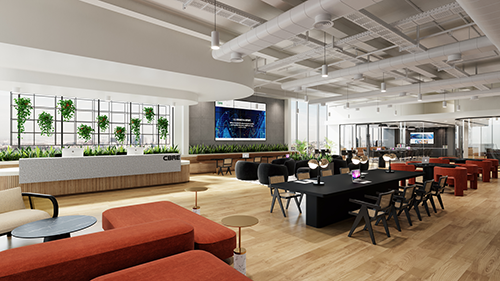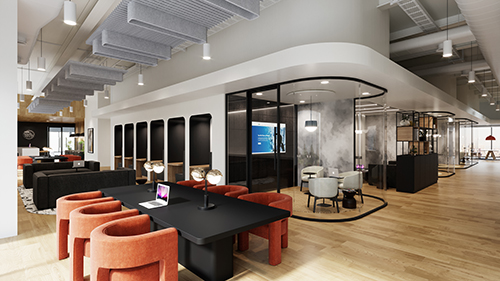Hotels and shopping centers have long strived to foster an ideal experience of their space for their users. It’s now the office’s turn.
The advent of widespread hybrid work has provided people multiple options of where to do their work on a given day. In turn, this shift has nudged employers to revamp their offices to make them more inviting, productive venues for their workers.
Fading into obsolescence are decades-old office staples like cubicle farms, rows of private offices and mandatory, five-day-a-week office attendance. Eclipsing them are features such as shared workstations, “resimercial” office design and multiple technologies that support hybrid work.
The end goal is for the office to provide an experience – much like hotels, restaurants, and shopping centers do – that not only helps in recruitment of new hires but also entices employees to gather and collaborate there. Underpinning that effort is technology that supports the experience by, among other things, allowing companies to efficiently manage shared workspaces and helping in-person and remote workers to work together as if they’re in the same room.
“Organizations now are thinking about their employees as consumers of an experience they provide,” said Lenny Beaudoin, global head of workplace & design at commercial real estate services company CBRE. “They’re not thinking of them just as employees who have to fit into a fixed number of seats but as colleagues they need to attract back to a more dynamic and flexible office with highly differentiated experiences than where they are.”
Many of these trends have become increasingly common in the past two years. A CBRE survey earlier this year of 185 companies with offices in the U.S. found that 73 percent intend to support various types of hybrid work formats for their employees. Still, 85 percent of respondents want their employees to spend at least half their work week in the office as part of their hybrid schedule.
To do so, companies plan to make the office more livable and efficient. Seventy-six percent of respondents are using or plan to install enhanced video conferencing technology such as a program that tracks and presents on the screen each participant – in-person and remote – as if they’re together. Fifty-three percent favor occupancy sensors to help them track, analyze and adapt to employees’ use of their workplace.
Further, 45 percent of respondents use or plan to add employee-experience apps that can allow employees to reserve desks and meetings rooms, check who plans to be in the office that day, and order various services, among other things.
These types of technologies and services are incorporated into a state-of-the-art, 30,794 square foot office that CBRE plans to open in Los Angeles’ South Bay area in August. There is history here; CBRE has highlighted workplace features such as unassigned seating, residential-type furniture and natural light since launching its Workplace360 office-design program in 2012. Now, the new South Bay office in El Segundo adds and enhances various workplace features inspired by analyzing hybrid work as it has evolved since the pandemic.
Case in point: the South Bay office offers 14 different workplaces, ranging from acoustically enclosed, single-person focus pods for individual work to huddle rooms for small teams, to project rooms with a horseshoe couch, large screens and interactive whiteboards. Other examples include residential-style living rooms for casual meetings, a library for quiet work, and an outdoor patio equipped with WiFi, seating and shade umbrellas.
The concept behind the 14 work zones is neurodiversity. People work in different ways on different projects on different days.
“It’s not a matter of coming back to a cubicle,” said Robert Peddicord, executive managing director of CBRE’s South Bay office. “It’s coming back into an environment – one in which people can work in different places and in different ways, depending on what they need that day.”
The office will provide a seating ratio of one workstation per 1.5 employees, a nod to hybrid work. It takes technology to manage such a shared workspace while continuing to study and improve employees’ experience in it. CBRE will use sensors to track the office’s overall occupancy and patterns of how often people use each area, room, desk and furniture. It then can adjust the office’s layout and other features to match those work patterns better.
“No one knows exactly what the future holds or exactly how people will use their office in the years ahead,” said Peter Van Emburgh, CBRE’s global head of real estate. “But now companies finally have access to real-time data to guide their strategy going forward on how to design and program their post-pandemic workplaces.”
Other technologies installed in the South Bay office, such as the enhanced video conferencing system, support hybrid work. Interactive whiteboards allow people in the conference room and those working remotely to write on the board at the same time.
Attention is paid to decidedly non-tech features as well. The office’s second-floor windows can be opened to allow a free flow of outdoor air. Full-height glass doors provide wide visibility and natural light.
All of these features can be enticing. But they need to be enticing enough to help people overcome one of the biggest barriers to the return to the office: The commute. Steven Davis, a University of Chicago business and economics professor who studies work trends, cites his ongoing survey of workers around the globe in reporting that people save an average of 65 minutes a day by foregoing their commute to instead work from home.
Many CBRE employees who work in the South Bay office live in the area, so their commutes aren’t lengthy. However, the new South Bay office is likely to influence other employees who normally take longer commutes to other CBRE’s offices in West Los Angeles and downtown to work in South Bay instead.
“The most effective, long-lasting way to change behavior is to provide people a superior option,” said Kasey Garcia, senior director of CBRE’s Workplace practice in the Southwest. “People will drive past multiple shopping centers to visit a better center. Some will even forego shopping online to go to their favorite center. Now the office is fully embracing consumer experience in the same way.”
Learn more at CBRE.com.


